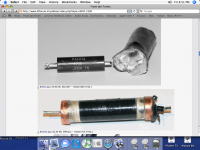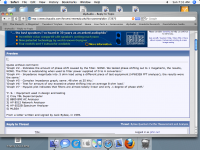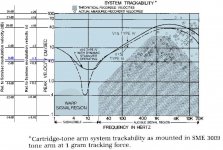Specifically the small Bybee you measured is a carbon nanotube resistor.
I assume you know better and are just trolling.
If it measures as a 0.025R resistor, with small inductance and little capacitance then that is how it behaves in a circuit. Measuring it puts it into a circuit! The only exception to this would be if it included a narrow-band filter, and the test used a different frequency so didn't hit the spot.john curl said:However, the device measures EFFECTIVELY as a 0.025 ohm resistor, with modest inductance (nanoHenries), almost 0 capacitance, so where is the BEEF?
A two-terminal passive component in a circuit can only interact with that circuit via its terminals or via coupled electric or magnetic fields. In the latter case you would see some capacitance or inductance - as the field has to couple to something in the component. No matter how magic are the nano-bits of which it is made, it must couple in one of these ways. No coupling means no circuit action.
Richard, why don't you get an individual Bybee device just like SY did and measure it? Here is some added input. The active Bybee is an other animal entirely, and you could easily measure its effects, but I don't own one.
Attachments
None of that matters today.... audiophiles must follow the leaders in industry. My comments are about the larger view of audio-video-data as a whole.
Hi-End is another story.... they are looking for the nitches to play in. I dont see seperates going away completely.... it is not where mainstream is going.
THx-RNMarsh
I don't see evidence of this yet, but happy to be proved wrong.
I'd like to know what this forth function is that we don't know about that describes something that is not covered by RLC? John, you just said that these three can not detect or describe the Bybee, not that I want to start this again, but what are you proposing that is being missed by classic electronic analysis? What is not described or falling under RLC in any electronic circuit? Are you going to name a new function here?
Just unplug the signal wire between two gears, like a preamp and an amp, and measure the V between the grounds of the two devices. (of course no earth connected). You can even feel the AC with your hand in certain circumstance. Capacitive coupling between primary and secondary of the trasfos, i believe. We are not overlooking-it.
C cores are better.
Richard, about active speakers, i'm going for it. But no way to double the active filter, neither to put-it in the enclosure. So, ouput of the active filter in digital, and one DAC for each speaker in each enclosure ? 6 for usual 3 ways enclosures ? Kind of expensive !
That is a good way to check or even measure the current flow between two chassis. I use a couple instruments which are also made to check it against Electrical code/standards. It doesnt take very much leakage at all when trying to measure below -100dB.
BTW - have you thought about using one of the Behringer cross-overs/DSP units ... excellent value and you could upgrade them inside, if you want. Done on another forum here.
THx-RNMarsh
Last edited:
Richard, why don't you get an individual Bybee device just like SY did and measure it?
He likes them so much, he won't give 'em back.
That ought to get them in the mail right quick.
To be honest, while I have heard the effects of Bybee devices, it is not always obvious, and may even detract, sometimes, from the overall sound quality. I have heard the negative, as well as the positive qualities. However they are rather expensive, and I don't recommend them to the vast majority of you, who are saving money by building your own 1 unit speakers, etc. It is just too expensive an addition to bother with.
I don't see evidence of this yet, but happy to be proved wrong.
Many, many products exist already and are sold by the millions as I described and more coming.
But not in high-end. Some signs it is started to enter there as well, though.
-RNM
Richard, why don't you get an individual Bybee device just like SY did and measure it? Here is some added input. The active Bybee is an other animal entirely, and you could easily measure its effects, but I don't own one.
I have same or equiv gear all except access to the Cray.
-RM
But Richard, you showed me my first CRAY computer. '-) decades ago. Remember, the letter was written 20 years ago, and the development done, perhaps 40 or so years ago. The computer time was used for development, not measurement. I have the measurements made in 1995, and they show little, if anything, and THAT is what I am warning you about.
That's quite respectable, as well as an easier schematic to follow.
I agree.
About the only thing of concern for me (although there are plenty of upgrades possible) is the 220pF loading, which is already close to the recommended C for many cartridges. With the tonearm wiring and interconnects it's apt to be considerably higher.
Yes, that capacitor can be replaced with a smaller one or removed.
I wonder how soon the rest of the signal chain overloads?
That's correct Brad
At 1kHz the gain of that RIAA pre is 35.5 dB.
So, at the overload limit (180mVrms input), the unit outputs a huge 10.7Vrms signal !
1 Vrms output is reached with a 16,8mVrms from the cartridge.
The Rec-Out reaches 1.28Vrms (the 0dB for many soundcards) with 21.6mV/1kHz rms from the cartridge.
That’s 18.7dB above the 0dB (5cm/s modulation velocity) for a 2.5mV cartridge, 12.7dB for a 5mV cartridge and 6.7dB for a 10mV cartridge.
It seems that for our current needs, for proper gain structure and no downstream overload , MM RIAA stages should have much lower gain than in the past, I would say around 20-22dB/1kHz. (A cartridge with 1mV/cm/s output, when reading a groove with a modulation of 26dB above the 5cm/s, it will supply 100mVrms. If the RIAA preamplifier output is to provide 1Vrms with such an input , it should have a gain of 20dB at 1kHz )
George
Attachments
Last edited:
I did so on a Rohde & Schwarz unit. Guess what? It's a resistor, wrapped in BS.
I'm not familiar with this BS material. Can you explain it in more detail. What are it's properties?
I'm not familiar with this BS material. Can you explain it in more detail. What are it's properties?
https://www.youtube.com/watch?v=008BPUdQ1XA
Many, many products exist already and are sold by the millions as I described and more coming.
But not in high-end. Some signs it is started to enter there as well, though.
-RNM
Examples? Beyond the AVI neutron, Meridians and the awful Sonos everything else is prosumer (behringer et al) that I can think of. Well and the NAIM soundbar.
Just to be clear although there is overlap in the Venn diagram I view general music lovers and audiophiles as 2 different groups with different purchasing habits.
All known scientific theories are effective theories, and lack an unshakable truth as a basis.
Even in mathematics, Kurt Godel showed the incompleteness of our best efforts.
Kurt Godel demonstrated that any formal system complex enough to express number theory cannot be both complete and consistent. That's a long way from saying "math is wrong". The physical instantiations of these formal systems are found on every desktop, in every data center, in medical and military installations, flying supersonic aircraft, guiding spacecraft, moving and managing trillions of dollars, and delivering porn. They seem to work pretty well.
The work of folks like Godel came from discomfort with the idea that mathematics can express apparent paradoxes. I kind of like that idea, and am very satisfied with a mathematics that is complete but inconsistent, but that's just me.
Richard, why don't you get an individual Bybee device just like SY did and measure it? Here is some added input. The active Bybee is an other animal entirely, and you could easily measure its effects, but I don't own one.
How can something that has no phase shift and flat magnitude response filter anything?? This is nonsense.
Jan
- Status
- Not open for further replies.
- Home
- Member Areas
- The Lounge
- John Curl's Blowtorch preamplifier part II


